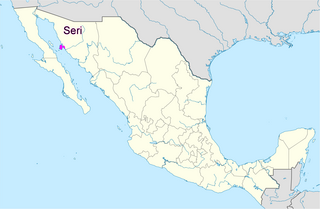| Seri | |
|---|---|
| cmiique iitom | |
| Pronunciation | [kw̃ĩːkɛˈiːtom] |
| Region | Sonora, Mexico |
| Ethnicity | Seri |
Native speakers | 720 (2020 census)[1] |
Hokan?
| |
| Language codes | |
| ISO 639-3 | sei |
| Glottolog | seri1257 |
| ELP | Seri |
 | |
 Seri is classified as Vulnerable by the UNESCO Atlas of the World's Languages in Danger | |
Seri (Seri: cmiique iitom) is an indigenous language spoken by between 716[2] and 900[3] Seri people in Punta Chueca and El Desemboque, two villages on the coast of Sonora, Mexico.[3] The language is generally considered an isolate, but attempts have been made to include it in the theoretical Hokan language family.[4] No concrete evidence has been found for connections to other languages.
The earliest records of the Seri language are from 1692,[5] but the population has remained fairly isolated. Extensive work on Seri began in 1951 by Edward and Mary Beck Moser with the Summer Institute of Linguistics.[6]
The language is viable within its community and is used freely in daily life. Exceptions include primary and secondary school, some parts of local church services, and communications with Spanish speakers outside of the Seri community.[7] Most members of the community, including youth, are fluent in their language, but the population of speakers is small and cultural knowledge has been dwindling since the traditional hunter-gatherer lifestyle was essentially replaced in the 1930s by fixed settlements. Furthermore, many children are no longer becoming fluent in the language, for a variety of reasons (schools, internet, or non-Seri friends); some children are completely monolingual in Spanish. For these reasons, Seri is listed as a vulnerable language by UNESCO.[8]
- ^ Lenguas indígenas y hablantes de 3 años y más, 2020 INEGI. Censo de Población y Vivienda 2020.
- ^ La situación sociolingüística de la lengua seri en 2006.
- ^ a b Ethnologue report for Seri
- ^ Cite error: The named reference
:1was invoked but never defined (see the help page). - ^ "The Seri Indians in 1692 as Described by Adamo Gilg". Arizona and the West. 7.
- ^ "Seri Texts".
- ^ Marlett, Stephen A (2006). "La situación sociolingüística de la lengua seri en 2006" (PDF).
- ^ "UNESCO".